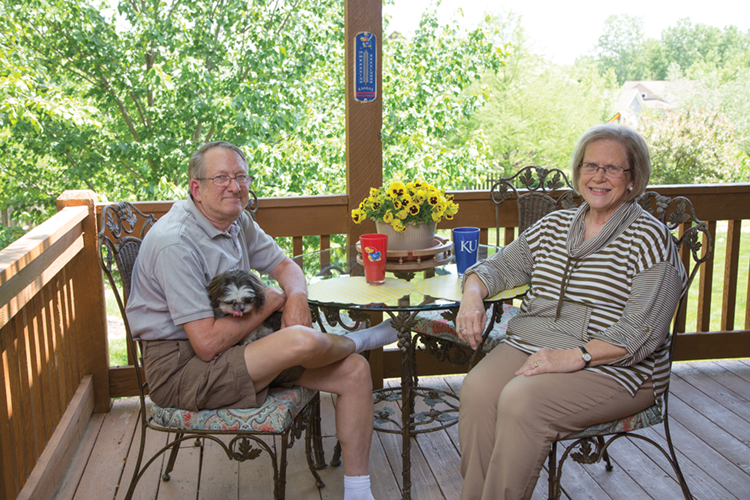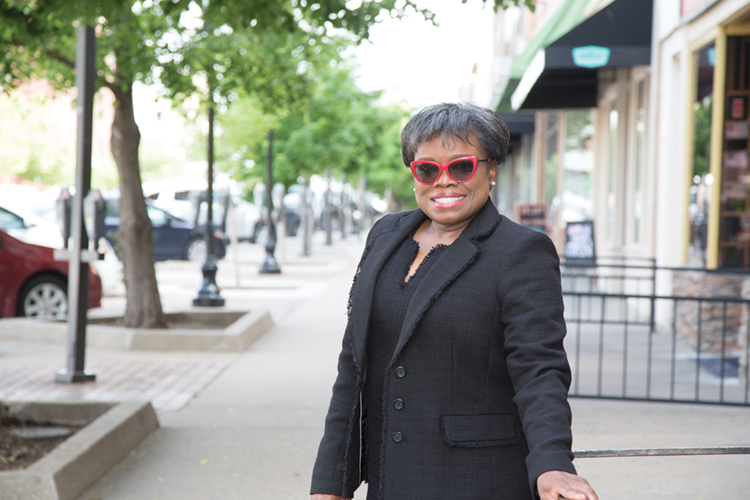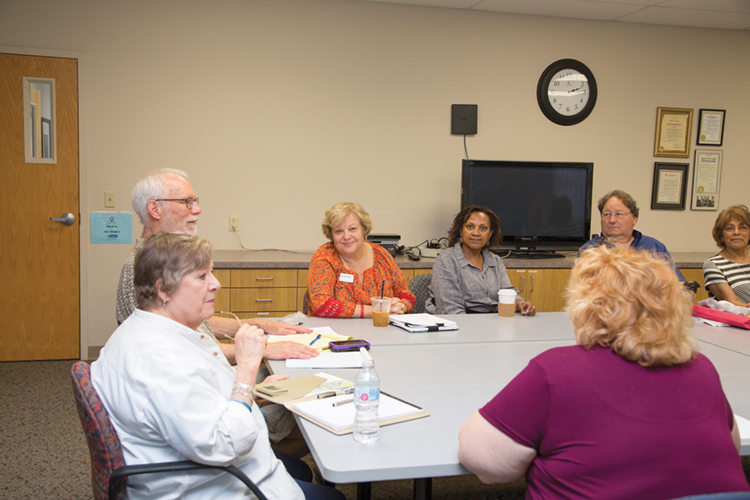The definition of a senior is shifting these days because of the longer, healthier lives people tend to lead.
| 2018 Q2 | story by Anne Brockhoff | photos by Steven Hertzog

When Jane and Dan Warren began thinking about retirement, they didn’t have rocking chairs in mind. Far from it. They wanted to continue the same active lives they’ve always led, just with more flexibility and leisure time; and they wanted to do it in Lawrence.
It’s familiar territory for the University of Kansas (KU) alums, who in 2014, moved back here from Omaha, Nebraska, where Dan had retired from Bellevue University’s communications arts faculty. He soon joined the Trinity Lutheran Church council and New Generation Society of Lawrence board, began teaching classes at the Osher Lifelong Learning Institute and became a Court Appointed Special Advocate in Douglas County.
Before the move, Jane had swapped her private clinical psychology practice for a full-time associate professorship in Bellevue’s clinical psychology program. She continues to teach now but looks forward to retiring after the 2018-19 academic year, so she can add more volunteer activities to her current involvement with the couple’s church and the KU University Women’s Club.
That might not sound like the stereotypical version of retirement, but sitting still has never really been an option, Jane says.
“Dan’s parents lived to be 86 and 90, my mother was 85, and my father is 101 and in reasonably good health,” she explains. “All four of our parents had retired earlier but were very active in the community. We both had those role models and knew retirement isn’t just sitting in a rocking chair.”

Jane and Dan Warren
While such commitment might have once seemed unique, it is increasingly the norm. Partly it’s because Americans are living longer, healthier lives, and their definition of “old” is shifting. The typical baby boomer (someone born between 1946 and 1964) sees 72 as the start of old age and feels nine years younger than his or her chronological age, according to a 2010 survey by the Pew Research Center.
They might reach an age at which retirement is acceptable, but instead of slowing down, they shift gears. Retirees today are embarking on encore careers or starting companies, connecting with causes and buying everything from homes and cars to smartphones. The spending and earnings of people older than 50, combined with the additional economic activity it spurs, is what the AARP calls the longevity economy.
“This population of older workers and retirees represents both a transformative force by itself, expected to account for more than half of U.S. GDP [gross domestic product]by 2032, and a net national asset—a fast-growing contingent of active, productive people who are working longer and taking the American economy in new directions,” according to “The Longevity Economy: Generating Economic Growth and New Opportunities for Business,” a study commissioned by the AARP in 2016.
The demographic feeding into such statistics is already big, and it’s getting bigger. One in seven Americans is now older than the age of 65. By 2040, that ratio will be one in five, according to the Administration for Community Living, a division of the U.S. Department of Health and Human Services.
Douglas County’s senior population has grown 24 percent over the last seven years, the Senior Resource Center for Douglas County’s website says. From 2010 to 2016, the overall population in all age groups grew nearly 8 percent, outstripping Johnson County, the state’s previous growth leader.
“The aging population isn’t on its way. It’s here,” says Arielle Burstein, associate director of the Milken Institute’s Center for the Future of Aging and coauthor of its report, “Silver to Gold: the Business of Aging.”
Providing health care, transportation and other services will be a challenge in some markets, and not all seniors benefit from the same income, education, health and support. But those challenges offer opportunities for businesses and communities that recognize and value the human capital represented by older Americans, Burstein says.
“The corporate community has just begun to test the economic power of older adults—their consumer strength, their product and service needs, and the wisdom and experience that they bring to the workforce as employees, mentors, and entrepreneurs,” Burstein’s report says.

Dr. Maren Turner, Director AARP Kansas”
EMPLOYMENT
Perhaps the greatest myth about retirement is that people of a certain age no longer want to work. In fact, 53 percent of workers don’t expect to retire until after age 65 or don’t plan to retire at all; 56 percent plan to continue working at least part-time in retirement, a report by the Transamerica Center for Retirement Studies explains.
Some will continue to work in their existing careers; others will seek new jobs; and plenty more will follow a more entrepreneurial path—people in their 50s and 60s launch new businesses at nearly twice the rate of people in their 20s, “Silver to Gold” reveals.
“At one point, you worked for a long time, probably at one company, then put in your retirement notice, had the party, went home and stopped working,” says Dr. Maren Turner, a Lawrence-based gerontologist, educator, Senior Resource Center board member and director of AARP Kansas. “Now, retirement means a lot of different things to different people.”
That’s especially true given the range of ages within the group. Today’s over-50s include not just baby boomers, but also Generation X (born between 1965 and 1980) and the Greatest and Silent generations (born before 1945).
“This is not a monolithic group,” Turner says.
Interests vary, as do needs. Some older Americans continue working because they require the income. Longer, healthier lives can translate into longer, more expensive retirements; yet only 27 percent of pre-retirees over the age of 50 feel financially prepared to finance their retirements for 10 years, much less 20 or 30, a 2017 survey by Bank of America Merrill Lynch shows.
Other older workers enjoy the social connections they make while working, and some are encouraged by research that links purposeful activity with improved mental and physical health. The benefits aren’t only on the retirees’ side, though.
Employers also do well to retain or hire older workers, Burstein says. Retention, no matter the age of the employee, is more cost-effective than recruiting and training new workers. Older workers also bring experience and expertise, and they have a positive effect on younger colleagues.
A multigenerational workforce adds to the bottom line, because “research shows productivity benefits by having an older person and younger person work on a project together,” Burstein says.
Employers willing to create flexible working arrangements, cross-train employees or offer job sharing can tap the pool of older workers most interested in working part-time. Training programs are also important, given that 67 percent of employees would be willing to learn new skills and try new jobs as they grow older, the Bank of America Merrill Lynch survey reveals.
Still, far too many employers underestimate the value of such workers, and ageism remains prevalent. Nearly two-thirds of U.S. workers ages 45 to 74 say they have seen or have personally faced discrimination based on age, according to the AARP.
There is still a tendency to lump older potential employees into a single category—old—and discount their potential in favor of hiring, training and promoting younger workers, the Milken Institute’s Burstein says. This usually unintentional bias could be mitigated through training or adopting different hiring methods, but those changes first require employers to confront their assumptions.
“That’s the strange thing about ageism,” Burstein says. “It’s the one form of discrimination we could all face.”

Judy Bellome
VOLUNTEERS
Not all retirees remain in the job market, though. A vast number, including Judy Bellome, of Lawrence, throw themselves into volunteer work.
Bellome, who began her nursing career in 1968, moved to Lawrence 13 years ago to become chief executive officer for the Douglas County Visiting Nurses Association. She considered taking on consulting projects after retiring in 2013 but instead focused on community involvement. She’s since provided leadership to the Senior Resource Center and Lawrence-Douglas County Advocacy Council on Aging, and volunteered with other organizations, including the Community Village Lawrence.
She is also an advocacy volunteer for AARP Kansas, has led the AARP Capitol City Task Force, was instrumental in getting the Kansas Lay Caregiver Act passed through the Kansas Legislature and, in 2017, was awarded the prestigious AARP Kansas Andrus Award for Community Service.
That all adds up to a busy schedule, but Bellome couldn’t be happier.
“This has been a real passion for me,” she says. “I have the best of both worlds. I’m using my skills in a voluntary way, but I can also take off when I want to.”
Volunteers such as Bellome do good for their communities, but they also have a massive combined economic impact. Americans older than 55 volunteered 3.3 billion hours in 2016 for an economic contribution worth $78 billion, according to the federal Corporation for National and Community Service.
As big as that number is, though, it pales to the older cohort’s consumer power. Americans over age 50 generate $7.6 trillion in direct spending and related economic activity, according to the AARP’s “Longevity Economy” report.
Research shows that older Americans dominate 119 out of 123 consumer packaged-goods categories, account for almost half of all vacation dollars spent annually, spend $90 billion on cars yearly and own nearly three-quarters of all financial assets.
It’s a demographic clearly worth enticing to retire in Lawrence or endeavoring to keep here. There’s plenty to attract them, including restaurants and shopping, as well as cultural amenities such as the Lied Center of Kansas, Lawrence Arts Center, Theatre Lawrence, the Spencer Museum of Art, Haskell Indian Art Market, local art galleries and other music and performance spaces. The county’s local and state parks and trails systems, golf courses, swimming facilities and recreation centers are also appealing, as is its proximity to Kansas City attractions and transportation options.
Then there are the educational cornerstones: KU, Baker University and Haskell Indian Nations University. Community resources like the Robert J. Dole Institute of Politics and Lawrence Public Library also add to the mix.
Lawrence’s health-care system, including Lawrence Memorial Hospital and access to the University of Kansas’s medical resources, also bolsters the city’s appeal to older residents. Enough so that Lawrence ranked eighth among smaller metros on the Milken Institute’s list of Best Cities for Successful Aging.
Still, the report notes challenges. Age-specific health services, in particular, are in short supply, and the cost of living is high.
Take real estate prices, for example. When the Warrens first visited Lawrence to look for a new home, “we had sticker shock,” Jane Warren says.
That trend hasn’t shifted. The average sale price of existing homes in Lawrence in March 2018 was $231,372, almost 22 percent more than a year earlier, according to the Lawrence Board of Realtors. “With limited inventory, prices are on the rise,” board president Henry Wertin noted in a press release.
Housing prices are only part of the financial puzzle. According to financial website SmartAsset.com, Douglas County was less affordable than many other Kansas counties once home prices, insurance costs, closing costs and other factors were taken into account and compared to the county’s median income.
And Lawrence scored in the bottom third of communities surveyed for income inequality, the number of jobs available per person, the multigenerational nature of the community, opportunities for social engagement, personal safety and air quality on the AARP’s online Livability Index calculator (livabilityindex.aarp.org).
Despite all that, though, Lawrence is on the right track toward making the city an even better place to live, Turner says.
“I think Lawrence is a great community,” she explains. “I know I’m biased because I live here, but I think we’re doing a lot of things right.”
Tackling these issues is essential if Douglas County is to continue attracting and retaining retirees, but it’s not just about older residents. Improving job opportunities, encouraging volunteerism, boosting health and housing resources, and creating an overall higher quality of life for the senior set will also benefit every generation that comes after.
“People get caught up in thinking we’re only talking about the boomers, but we’re not,” the Milken Institute’s Burstein says. “We’re really talking about everyone.”

Lawrence Farmers Market
